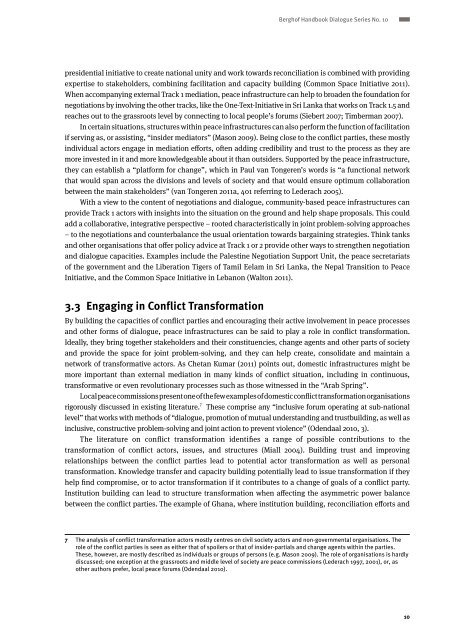Giving Peace an Address? - Berghof Handbook for Conflict ...
Giving Peace an Address? - Berghof Handbook for Conflict ...
Giving Peace an Address? - Berghof Handbook for Conflict ...
You also want an ePaper? Increase the reach of your titles
YUMPU automatically turns print PDFs into web optimized ePapers that Google loves.
<strong>Berghof</strong> H<strong>an</strong>dbook Dialogue Series No. 10<br />
presidential initiative to create national unity <strong>an</strong>d work towards reconciliation is combined with providing<br />
expertise to stakeholders, combining facilitation <strong>an</strong>d capacity building (Common Space Initiative 2011).<br />
When accomp<strong>an</strong>ying external Track 1 mediation, peace infrastructure c<strong>an</strong> help to broaden the foundation <strong>for</strong><br />
negotiations by involving the other tracks, like the One-Text-Initiative in Sri L<strong>an</strong>ka that works on Track 1.5 <strong>an</strong>d<br />
reaches out to the grassroots level by connecting to local people’s <strong>for</strong>ums (Siebert 2007; Timberm<strong>an</strong> 2007).<br />
In certain situations, structures within peace infrastructures c<strong>an</strong> also per<strong>for</strong>m the function of facilitation<br />
if serving as, or assisting, “insider mediators” (Mason 2009). Being close to the conflict parties, these mostly<br />
individual actors engage in mediation ef<strong>for</strong>ts, often adding credibility <strong>an</strong>d trust to the process as they are<br />
more invested in it <strong>an</strong>d more knowledgeable about it th<strong>an</strong> outsiders. Supported by the peace infrastructure,<br />
they c<strong>an</strong> establish a “plat<strong>for</strong>m <strong>for</strong> ch<strong>an</strong>ge”, which in Paul v<strong>an</strong> Tongeren’s words is “a functional network<br />
that would sp<strong>an</strong> across the divisions <strong>an</strong>d levels of society <strong>an</strong>d that would ensure optimum collaboration<br />
between the main stakeholders” (v<strong>an</strong> Tongeren 2011a, 401 referring to Lederach 2005).<br />
With a view to the content of negotiations <strong>an</strong>d dialogue, community-based peace infrastructures c<strong>an</strong><br />
provide Track 1 actors with insights into the situation on the ground <strong>an</strong>d help shape proposals. This could<br />
add a collaborative, integrative perspective – rooted characteristically in joint problem-solving approaches<br />
– to the negotiations <strong>an</strong>d counterbal<strong>an</strong>ce the usual orientation towards bargaining strategies. Think t<strong>an</strong>ks<br />
<strong>an</strong>d other org<strong>an</strong>isations that offer policy advice at Track 1 or 2 provide other ways to strengthen negotiation<br />
<strong>an</strong>d dialogue capacities. Examples include the Palestine Negotiation Support Unit, the peace secretariats<br />
of the government <strong>an</strong>d the Liberation Tigers of Tamil Eelam in Sri L<strong>an</strong>ka, the Nepal Tr<strong>an</strong>sition to <strong>Peace</strong><br />
Initiative, <strong>an</strong>d the Common Space Initiative in Leb<strong>an</strong>on (Walton 2011).<br />
3.3 Engaging in <strong>Conflict</strong> Tr<strong>an</strong>s<strong>for</strong>mation<br />
By building the capacities of conflict parties <strong>an</strong>d encouraging their active involvement in peace processes<br />
<strong>an</strong>d other <strong>for</strong>ms of dialogue, peace infrastructures c<strong>an</strong> be said to play a role in conflict tr<strong>an</strong>s<strong>for</strong>mation.<br />
Ideally, they bring together stakeholders <strong>an</strong>d their constituencies, ch<strong>an</strong>ge agents <strong>an</strong>d other parts of society<br />
<strong>an</strong>d provide the space <strong>for</strong> joint problem-solving, <strong>an</strong>d they c<strong>an</strong> help create, consolidate <strong>an</strong>d maintain a<br />
network of tr<strong>an</strong>s<strong>for</strong>mative actors. As Chet<strong>an</strong> Kumar (2011) points out, domestic infrastructures might be<br />
more import<strong>an</strong>t th<strong>an</strong> external mediation in m<strong>an</strong>y kinds of conflict situation, including in continuous,<br />
tr<strong>an</strong>s<strong>for</strong>mative or even revolutionary processes such as those witnessed in the “Arab Spring”.<br />
Local peace commissions present one of the few examples of domestic conflict tr<strong>an</strong>s<strong>for</strong>mation org<strong>an</strong>isations<br />
rigorously discussed in existing literature. 7 These comprise <strong>an</strong>y “inclusive <strong>for</strong>um operating at sub-national<br />
level” that works with methods of “dialogue, promotion of mutual underst<strong>an</strong>ding <strong>an</strong>d trustbuilding, as well as<br />
inclusive, constructive problem-solving <strong>an</strong>d joint action to prevent violence” (Odendaal 2010, 3).<br />
The literature on conflict tr<strong>an</strong>s<strong>for</strong>mation identifies a r<strong>an</strong>ge of possible contributions to the<br />
tr<strong>an</strong>s<strong>for</strong>mation of conflict actors, issues, <strong>an</strong>d structures (Miall 2004). Building trust <strong>an</strong>d improving<br />
relationships between the conflict parties lead to potential actor tr<strong>an</strong>s<strong>for</strong>mation as well as personal<br />
tr<strong>an</strong>s<strong>for</strong>mation. Knowledge tr<strong>an</strong>sfer <strong>an</strong>d capacity building potentially lead to issue tr<strong>an</strong>s<strong>for</strong>mation if they<br />
help find compromise, or to actor tr<strong>an</strong>s<strong>for</strong>mation if it contributes to a ch<strong>an</strong>ge of goals of a conflict party.<br />
Institution building c<strong>an</strong> lead to structure tr<strong>an</strong>s<strong>for</strong>mation when affecting the asymmetric power bal<strong>an</strong>ce<br />
between the conflict parties. The example of Gh<strong>an</strong>a, where institution building, reconciliation ef<strong>for</strong>ts <strong>an</strong>d<br />
7 The <strong>an</strong>alysis of conflict tr<strong>an</strong>s<strong>for</strong>mation actors mostly centres on civil society actors <strong>an</strong>d non-governmental org<strong>an</strong>isations. The<br />
role of the conflict parties is seen as either that of spoilers or that of insider-partials <strong>an</strong>d ch<strong>an</strong>ge agents within the parties.<br />
These, however, are mostly described as individuals or groups of persons (e.g. Mason 2009). The role of org<strong>an</strong>isations is hardly<br />
discussed; one exception at the grassroots <strong>an</strong>d middle level of society are peace commissions (Lederach 1997, 2001), or, as<br />
other authors prefer, local peace <strong>for</strong>ums (Odendaal 2010).<br />
10
















